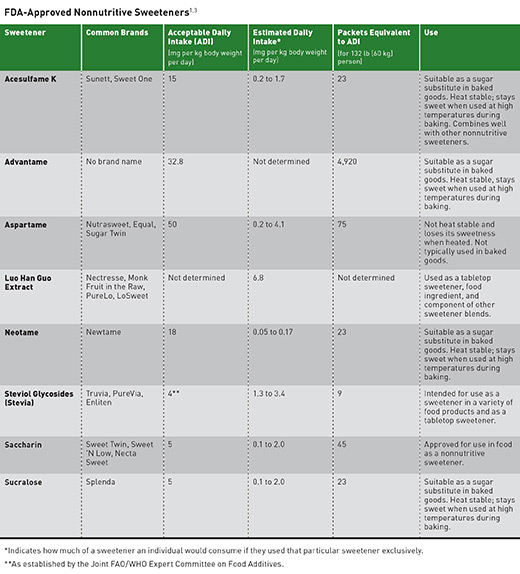By Constance Brown-Riggs, MSEd, RD, CDE, CDN
Patients with diabetes often ask which sweeteners are best for them; what makes those sweeteners a good choice? Are there limits on how much of a given sweetener they can consume each day? If you counsel people with diabetes, chances are you’re frequently asked these questions.
This article will discuss the different types of sweeteners that grace store shelves, which ones are best used for baking, and what is their acceptable daily intake (ADI). It will also provide tips for counseling patients.
Types of Sweeteners
Sweeteners can be placed into two main categories: nutritive and nonnutritive. Nutritive sweeteners, often referred to as caloric sweeteners or sugars, contain carbohydrate and thus provide calories. Nonnutritive sweeteners, also known as high-intensity sweeteners or low-calorie sweeteners, provide few or no calories. People with diabetes can safely consume both types of sweeteners.
Currently, the FDA has approved the following eight nonnutritive sweeteners for use: acesulfame K, advantame, aspartame, luo han guo extract, neotame, stevia, saccharin, and sucralose.1
“The Academy of Nutrition and Dietetics [the Academy] position paper on sweeteners advises people can safely consume nonnutritive or nutritive sweeteners when they are part of a healthy eating plan,” says Toby Smithson, MSNW, RDN, LDN, CDE, a spokesperson for the Academy. Furthermore, the American Heart Association, American Diabetes Association (ADA), and Academy agree that nonnutritive sweeteners can help people with diabetes achieve glucose control.2,3
Personal preference, metabolic goals, and functionality are key factors in determining which sweetener is best for the person with diabetes. Joanne Rinker, MS, RD, LDN, CDE, FAADE, senior director for community health improvement at Population Health Improvement Partners in Morrisville, North Carolina, steers her patients toward nutritive sweeteners. “I prefer to stay away from chemicals and choose natural sweeteners,” says Rinker, a spokesperson for the American Association of Diabetes Educators. Her favorite nutritive sweeteners are sugar, brown sugar, honey, and pure maple syrup.
Nutritive sweeteners should be used in the context of a healthful eating pattern without increasing caloric intake. The ADA’s 2013 position statement, “Nutrition Therapy Recommendations for the Management of Adults With Diabetes,” suggests that the total number of carbohydrates and the individual’s available insulin are the most important factors influencing metabolic goals, eg, glycemic response after eating, and should be considered when developing the eating plan.
When it comes to functionality, Smithson, coauthor of Diabetes Meal Planning and Nutrition for Dummies, says not all sweeteners are the same. “Aspartame cannot be used for baking because it is not heat stable, but saccharin, acesulfame K, sucralose, and stevia can be used in baking. Also worthy of noting is that your baked products may have a different volume because nonnutritive sweeteners don’t have the same bulk as sugar.”
Counseling Patients
The FDA has established an ADI for each of the approved nonnutritive sweeteners. The chart below can assist dietitians when counseling patients on the ADI and use of these FDA-approved nonnutritive sweeteners.
The 2015–2020 Dietary Guidelines for Americans recommend limiting added sugars to less than 10% of calories per day. “It’s important to note the recommendation for all sweeteners is four to nine teaspoons per day,” says Rinker, who encourages her patients to think about how much of a sweetener they really need to satisfy their taste. When baking with nutritive sweeteners, Rinker suggests eating smaller portion sizes or cutting back on the amount of sweetener used. She gives the same recommendations for sweetened beverages. “Try them without sweeteners, or use less. Typically, over time you get used to the less or unsweetened version,” Rinker says.
Informed Choice
When counseling clients, dietitians should give patients evidenced-based information about the use of nutritive and nonnutritive sweeteners that will enable them to make informed choices and achieve their best glucose control.
— Constance Brown-Riggs, MSEd, RD, CDE, CDN, is past national spokesperson for the Academy of Nutrition and Dietetics, specializing in African American nutrition, and author of The African American Guide to Living Well With Diabetes and Eating Soulfully and Healthfully With Diabetes.
References
1. US Food and Drug Administration. Additional information about high-intensity sweeteners permitted for use in food in the United States. http://www.fda.gov/Food/IngredientsPackagingLabeling/FoodAdditivesIngredients/
ucm397725.htm. Updated May 26, 2015. Accessed July 29, 2016.
2. American Diabetes Association. American Heart Association/American Diabetes Association scientific statement: non-nutritive sweeteners: a potentially useful option — with caveats. http://www.diabetes.org/newsroom/press-releases/2012/
ada-aha-sweetener-statement.html – sthash.ZjkiflPh.dpuf. Published July 9, 2012. Accessed July 29, 2016.
3. Fitch C, Keim KS, Academy of Nutrition and Dietetics. Position of the Academy of Nutrition and Dietetics: use of nutritive and nonnutritive sweeteners. J Acad Nutr Diet. 2012;112(5):739-758.



